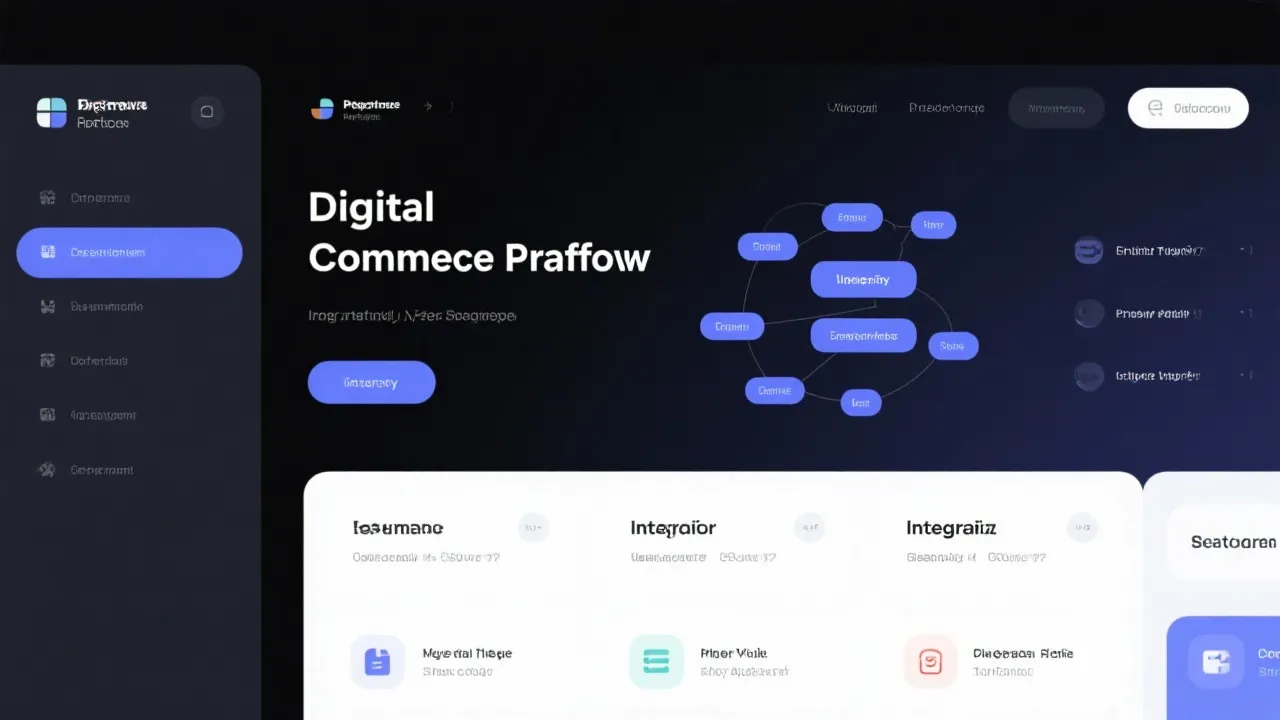Vtex vs Salesforce Commerce: An In-Depth Analysis
This guide explores the essential differences between two leading e-commerce platforms: Vtex and Salesforce Commerce. Both provide unique features tailored to various business needs. Analyzing their capabilities is essential for businesses seeking to optimize their online strategies, enhance customer experience, and scale operations effectively. Dive into expert insights and learn how these platforms can align with your e-commerce goals.

Understanding E-Commerce Platforms: Vtex and Salesforce Commerce
The e-commerce landscape is constantly evolving, introducing innovative platforms designed to meet diverse business requirements. Two significant contenders in this space are Vtex and Salesforce Commerce. Both platforms offer distinctive features that cater to varied business sizes and industries. This article delves into a detailed comparative analysis of Vtex and Salesforce Commerce, helping businesses determine the top fit for their e-commerce needs.
The Evolution and Market Positioning of Vtex
Vtex is a cloud-based e-commerce platform known for its flexibility and speed, making it easy for businesses to scale and adapt to market changes. Founded in 1999, Vtex initially aimed to disrupt traditional retail with its suite of technology solutions. Over the years, it has expanded its services to include functionalities like intelligent search, inventory management, and order fulfillment. A key strength of Vtex is its collaborative commerce ethos, allowing businesses to integrate seamlessly with multiple partners and third-party applications, thereby creating comprehensive ecosystems.
Today's digital consumers expect seamless shopping experiences, and Vtex has positioned itself to provide those. Their platform is equipped with tools that enable brands to go to market faster while maintaining a high degree of customization. A significant aspect of Vtex's appeal is its ability to manage various sales channels, including web, mobile, and in-store experiences, from a centralized platform. This omnichannel capability ensures that brands can connect with customers wherever they are, increasing engagement and loyalty.
Salesforce Commerce Cloud: An Enterprise Solution
Salesforce Commerce Cloud is part of the larger Salesforce ecosystem, providing robust functionality focused on customer engagement and personalization. Established as a leader in CRM solutions, Salesforce has leveraged its extensive business intelligence capabilities to create a powerful e-commerce platform tailored for the needs of large enterprises. It is particularly popular among organizations that require advanced tools to manage sophisticated marketing strategies and customer relationships.
The platform is renowned for its ability to offer tailored customer experiences through AI and advanced analytics, which help in understanding consumer behavior and enhancing marketing strategies. Salesforce Commerce Cloud enables businesses to create relevant, personalized shopping experiences by analyzing user data, such as browsing and purchasing history. This data-driven approach allows brands to deliver targeted promotions, recommendations, and unique customer journeys, thus increasing conversion rates and customer satisfaction.
Moreover, the integration of various Salesforce products like Marketing Cloud and Service Cloud allows businesses to harmonize their marketing efforts and customer service. This symbiosis further empowers organizations to retain customers and ensure their ongoing loyalty. Brands that invest in leveraging the full Salesforce ecosystem can gain a strategic advantage by creating a unified view of their customers, which can help to streamline customer-facing operations dramatically.
Key Features and Capabilities
When comparing Vtex and Salesforce Commerce, a nuanced understanding of their features can guide businesses in making strategic decisions. The table below summarizes the key aspects of both platforms:
| Feature | Vtex | Salesforce Commerce |
|---|---|---|
| Integration Flexibility | High; supports numerous third-party apps | Moderate; excellent within the Salesforce ecosystem |
| Customization | Offers significant customization options | Customizable, especially with Salesforce's ecosystem |
| Order Management | Advanced tools for global operations | Integrated with Salesforce CRM for comprehensive management |
| AI Capabilities | Utilizes AI for smart recommendations | Strong AI integration, enhancing personalization |
| Pricing Structures | Flexible pricing based on usage | Higher price point, often favored by larger enterprises |
Understanding the Pricing Model
Pricing is a critical consideration for any business. Vtex offers a flexible pricing model that scales with the size of the business and its operations. This model is advantageous for small to medium-sized businesses looking to control operating costs. Vtex typically employs a transaction-based pricing structure, ensuring that costs are commensurate with actual sales and performance. This approach allows businesses to maintain a more predictable expenditure, particularly valuable for startups and emerging companies navigating early growth phases.
On the other hand, Salesforce Commerce's pricing tends to be higher, primarily because it delivers a comprehensive feature set ideal for enterprises seeking to leverage advanced CRM integration and analytics. Salesforce often operates on a subscription model, which can represent a significant investment, but for many large organizations, the return on investment (ROI) realized through enhanced customer relationships and operational efficiencies can justify the expenditure. Companies considering Salesforce must align their budgets with the potential revenue uplift from utilizing its full capabilities, as the platform is designed to enhance long-term growth and scale effectively with their operations.
Localization Capabilities
Both Vtex and Salesforce Commerce enable businesses to target markets near specific locales by offering localized features. These include region-specific currencies, language support, and localized promotions. Understanding the cultural nuances and consumer behavior in different regions can provide a competitive advantage, and both platforms offer robust solutions to meet these needs.
Vtex is particularly strong in enabling brands to effortlessly enter Latin American markets, where it has established a strong foothold. Its tools offer businesses the unique ability to customize their offerings according to local customs, trends, and market requirements. Features like customizable landing pages and region-specific payment gateways contribute to a more localized and familiar shopping experience for consumers in that area.
Meanwhile, Salesforce Commerce Cloud excels in markets that require sophisticated data integration and analytics capabilities. Its ability to leverage customer data across various touchpoints enables personalized marketing strategies that can be fine-tuned for diverse audiences. Salesforce provides tools that allow businesses to adjust their campaigns and promotions swiftly, responding to real-time market demands. Such agility empowers brands to engage effectively with customers and build loyalty across different regions and demographics.
Industry Expert Insights
Experts from the e-commerce industry emphasize the need for a strategic technology partner. Whether a business chooses Vtex or Salesforce Commerce largely depends on its specific operational needs, budget, and scale. For instance, enterprises valuing deep integration with CRM may gravitate towards Salesforce, whereas those seeking agility and collaborative ecosystems might lean towards Vtex.
In assessing the right platform, industry consultants often recommend a thorough evaluation of short- and long-term goals. Companies must consider their growth trajectory, customer demographic, and operational complexities. In addition, expert insights suggest that businesses should prioritize their ability to scale and innovate within the chosen platform. For example, companies that are expanding rapidly in emerging markets may prefer Vtex for its flexibility, while established enterprises may find Salesforce's sophisticated tools better align with their structured operations.
Networking with peers and engaging with case studies can further inform decision-making. Many businesses have carved successful paths by learning from the experiences of others who have implemented either Vtex or Salesforce Commerce. Consulting industry reports that benchmark different platforms can also provide valuable insights that help businesses navigate their choices more judiciously.
FAQs
- Which platform is more suitable for small businesses?
Vtex is typically more favorable for small to medium enterprises due to its flexible pricing and ease of integration with various applications.
- Can both platforms handle multinational operations?
Yes, both platforms offer comprehensive tools for managing multinational operations, including multi-currency and multi-language support.
- How do the AI capabilities of both platforms compare?
While both platforms harness AI to enhance customer experience, Salesforce Commerce benefits from deeper analytics integration due to its CRM heritage.
- What are the latest innovations on these platforms?
Recent updates in Vtex focus on collaborative commerce, while Salesforce Commerce continuously integrates AI advancements for higher personalization.
- How important is omnichannel retailing for my business?
Omnichannel retailing is becoming essential as consumers demand cohesive shopping experiences across multiple channels. Both Vtex and Salesforce Commerce provide features that facilitate seamless transitions between different purchasing points.
- What should businesses prioritize when selecting an e-commerce platform?
Businesses should prioritize scalability, ease of integration with existing systems, customer support, and features that align with their strategic goals. Conducting a thorough needs assessment can help clarify the best choice for each specific business context.
- Are there specific industries that benefit more from either platform?
While both platforms cater to varied industries, Vtex tends to be favored in sectors like retail and fashion, especially in Latin America, while Salesforce Commerce Cloud is often the go-to solution for larger enterprises in technology, electronics, and services.
Conclusion
In the competitive arena of e-commerce, choosing the right platform is a crucial step towards achieving business success. Vtex and Salesforce Commerce Cloud surface as powerful contenders each with their specialized features tailored to distinct business needs. Businesses must assess their operational requirements, budget limitations, and growth aspirations carefully before deciding.
Vtex particularly shines in its ability to support fast-paced, agile businesses looking for cost-effective solutions and more collaborative commerce ecosystems. Its straightforward integration capabilities and focus on omnichannel strategies make it particularly suited to those aiming for growth in emerging markets.
Salesforce Commerce Cloud, conversely, offers an embedded suite of powerful tools that can elevate a business's CRM capabilities and marketing strategies. Its robust framework is ideal for enterprises looking to leverage data-driven insights, engage customers through personalized experiences, and strengthen customer relationships over time.
Ultimately, whether businesses decide upon Vtex or Salesforce Commerce should align with their strategic vision and operational needs. Regularly reviewing and adapting their chosen platform to suit evolving market demands and consumer preferences may also set firms on the path to sustainable success in the ever-changing digital marketplace.
-

A Guide to Cost-Efficient Small Electric Cars for Seniors
-

Mastering Debt Consolidation: Boost Your Credit Score and Manage Interest Rates
-

Your Guide to Loans, Credit Checks, and Interest Rates
-

Affordable Independent Living: Finding the Right Senior Housing
-

Guide to Senior Living Apartments: Affordable and Comfortable Environments









